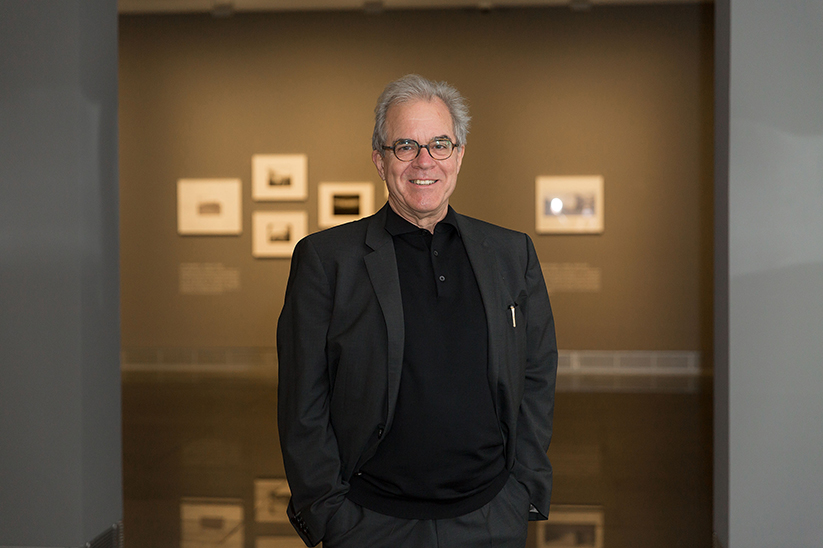Manolo Laguillo at the MUN: "I am not interested in the usual photogenic style but in giving testimony to our children and grandchildren of what the city was like and how we lived".
For the first time, the artist exhibits the complete 'The Provinces', a project created for the Museum's artistic residency program Tender Puentes , inspired by his collection.

FotoManuelCastells/Artist Manolo Laguillo in one of the exhibition rooms of the MUN.
27 | 10 | 2021
A journey through four decades of work through cities as disparate as Barcelona, Soria, Chicago, Beirut or Gandía where to explore the footprint of time and human impact on their landscapes. This is the proposal of the exhibition Projects: four decadesby Manolo Laguillo (Madrid, 1953), curated by Valentín Roma and co-produced by Museo Universidad de Navarra and La Virreina Centre de la Imatge de Barcelona. It can be visited at the MUN until March 20.
The exhibition, sponsored by Correos, brings together 279 photographs, divided into 28 series that include works made since 1983, with the set dedicated to the floods in Bilbao, until 2020, with images of the confinement in Barcelona. In addition, he presents for the first time Oporto and it is the first time that it can be seen in its entirety. The Provinces 2014-2015The Provinces 2014-2015, a project carried out as part of the Museum's artistic residency program Tender Puentes the Museum's artistic residency program, inspired by its photography collection. The series brings together 65 diptychs on eight Spanish cities (Cáceres, Zamora, Palencia, Soria, Segovia, Teruel, Ciudad Real and Jaén), located between the center of the country and the periphery, cities that allow him to address issues such as Empty Spain and the changes brought about by industrialization.
In his presentation to the media, in which he was accompanied by Valentin Roma and Jaime Garcia del Barrio, director of the MUN, Laguillo explained that something that his works share is the way of looking at the city, transiting it: "There is a consideration of the city as the largest object that can generate the human being. Also, those who make it are mostly anonymous and this collective subject interests me".
For his part, the curator stressed that the exhibition "shows a variety of prisms and approaches, some non-Western, such as those of Japan. Therefore, it questions and amplifies the gaze of a photographer historically associated with Barcelona. We observe in his trajectory that there is not such a unilateral link". Another key is that "he shows a way of approaching the photographic document, which makes his photography very unique: walking, discovering the city as he goes along, street photography that is built from the naturalness of the eye that discovers as it moves. There is a 'sensuality' that is not at odds with the photographic document".
Curated by Valentín Roma and co-produced with La Virreina Centre de la Imatge de Barcelona, it brings together 279 photographs ranging from 1983 to 2020, with images of the confinement
DOCUMENTARY PHOTOGRAPHY
The artist also pointed out other elements that act as a common thread in his works, such as the Mediterranean axis, from the Iberian Peninsula to Beirut (Lebanon), and the river, although not always in a very explicit way: "Water is very present in the work dedicated to the Strait of Gibraltar, in the work on nuclear power plants, which depend on water; also the Duero is present in several of the cities of The provinces...". On the absence of human beings in his images, the photographer has clarified that in some series they do appear, but "the difference in size between people and buildings is so great that if I want to photograph the buildings, the people disappear. And that is a characteristic of the contemporary city that fascinates me.
In this sense, he has also pointed out that, as a documentary photographer, he is not interested in "a photogenic image, but that they can serve our children, grandchildren and great-grandchildren to know how the city was and how we lived, to give testimony". For this reason, he focuses his gaze on what he considers significant elements, above all, "the places where the different urban fabrics, the neighborhoods, rub together, where there is a conflict between the old and the new". With this perspective, emptiness plays a fundamental role through which he also refers to a temporal dimension.
ACTIVITIES AROUND THE EXHIBITION
Exposure time:
-
To share his artistic career and the keys to this exhibition, Laguillo will offer a masterclass this Wednesday at 7 p.m. in the Museum Theater. At the end, the exhibition rooms will be opened.
-
Thursday, January 12. Lecture by Ila Bêka and Louise Lemoine, from the art and architecture studio BÊKA & LEMOINE. Based on their documentary series Homo Urbanus, on the tension between the local and the global in the contemporary representation of the city.
-
Thursday, February 24. Round table moderated by Professor Jordi Puig on artistic initiatives in rural areas, with the participation of artists Ricardo Calero, Lucía Loren and Fernando García Dori.
Plan/Counterplan:
-
Cinema. Cycle of documentaries on "Empty Spain": Thursdays, January 13, 20, 27 and February 3, 10 and 17.
Family workshops:
-
November 19. Panorama. Activity for teenagers (13 to 18 years old) around the exhibition.
In January, the activities aimed at the University of Navarra Campus will be announced.
PRESS SITE: https://museo.unav.edu/prensa/proyectos-cuatro-decadas-manolo-laguillo